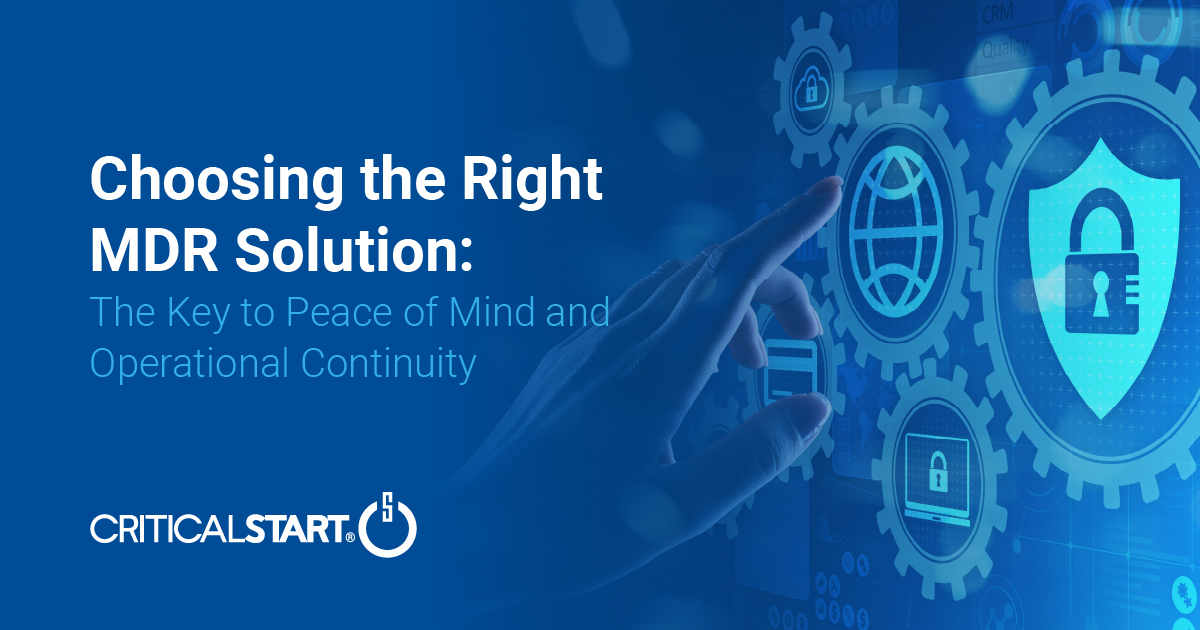Choosing the Right MDR Solution: The Key to Peace of Mind and Operational Continuity

Imagine this: an attacker breaches your network, and while traditional defenses scramble to catch up, your organization suffers financial losses, operational disruptions, and reputational damage. This scenario isn’t just theoretical — it’s a reality for countless businesses navigating today’s complex threat landscape.
Selecting the right Managed Detection and Response (MDR) provider is one of the most impactful decisions you can make for your organization’s security. Beyond detection, human-driven MDR that provides consistent, expert-driven analysis and true response mitigation— the ability to contain and neutralize threats in real time — is the linchpin of effective cybersecurity. The right MDR solution doesn’t just safeguard your systems; it fits your organization’s evolving risk profile and safeguards your peace of mind.
The Critical Role of True Response Mitigation
Nuanced threat detection by seasoned security experts includes analyzing context, intent, and subtle indicators of compromise to recognize complex attack patterns and behaviors. This forms the backbone of effective response capabilities— like true response mitigation — helping contain threats quickly and preventing incidents from escalating into full-blown crises. According to the IBM Cost of a Data Breach Report 2024, breaches that take more than 200 days to detect and contain cost an average of $5.46 million — nearly 50% more than breaches contained quickly. An MDR service that offers true response mitigation through features like clear response authorization processes and pre-defined threat response actions based on alert and asset criteria can help you cut that timeline drastically, reducing costs and protecting your organization’s reputation.
Think of true response mitigation as your cyber safety net. Instead of merely alerting you to a problem, Security Operations Center (SOC) analysts operate as an extension of your team to isolate compromised systems, prevent lateral movement, and contain threats before they disrupt your business. In today’s sophisticated threat environment, response capabilities aren’t optional — they’re essential.
How the Right MDR Solution Makes a Difference
1. Reducing Breach Costs with Swift Response
Every second matters during a breach. Rapid detection and containment not only minimize financial losses but also protect your organization’s trustworthiness. According to IBM, breaches detected by attackers rather than internally cost an average of $5.53 million. The right MDR solution equips you to identify and contain breaches internally, keeping costs — and reputational risks — under control.
2. Preventing Escalation with Proactive Defense
The rise in vulnerabilities — a 180% increase in attacks exploiting weaknesses — means attackers are moving faster and deeper into networks than ever before (2024 Data Breach Investigations Report). An MDR solution that prioritizes proactive containment across a multi-vector threat landscape helps prevent bad actors from gaining initial entry, protecting critical systems and infrastructure.
For you, this means fewer sleepless nights worrying about the “what-ifs” and more confidence that your MDR provider has you covered.
3. Leveraging Automation for Faster Mitigation
Automation to resolve known good behaviors, reduce false positives, and more is a game-changer in today’s cybersecurity landscape. But it’s most effective when paired with skilled human oversight. AI-driven threat detection handles known threats, while human analysts step in for the complex, nuanced incidents that require critical thinking. This balance ensures a faster, more precise response, reducing exposure and keeping your operations seamless.
4. Tailored Protection for Your Unique Needs
Every organization is different, and so are its security needs. The right MDR solution offers tailored Rules of Engagement (ROE) that align with your infrastructure, regulatory requirements, and priorities. This customized approach ensures that your defenses are both proactive and adaptable, minimizing operational disruptions and maximizing business continuity.
Imagine a world where even during an incident, your organization runs smoothly because your MDR provider anticipates potential vulnerabilities and adapts in real time. That’s the power of tailored incident response.
Building Resilience Through Continuous Improvement
Cyber threats don’t stand still, and neither should your defenses. The best MDR solutions evolve alongside your organization, continuously monitoring security coverage gaps and implementing lessons learned from past incidents to strengthen your security posture. By prioritizing risks, addressing vulnerabilities, and enhancing response strategies with actions that align with your evolving needs, your MDR provider ensures you’re prepared for the challenges of tomorrow.
For you, this means reduced long-term costs, fewer operational disruptions, and greater confidence in your organization’s resilience.
The Outcomes That Matter
Choosing the right MDR solution isn’t just about stopping threats — it’s about empowering your organization to thrive. Here’s what you gain:
- Lower Costs: Swift detection and containment reduce financial losses from breaches.
- Peace of Mind: Proactive defense and tailored strategies ensure your organization stays ahead of threats.
- Operational Continuity: Even during incidents, the right MDR provider minimizes disruptions, keeping your business running smoothly.
Are You Ready to Make the Right Choice?
As data breach costs continue to rise, the importance of true response mitigation has never been clearer. The right MDR solution doesn’t just react to threats — it empowers organizations to identify potential security gaps for optimal prevention and delivers response actions to protect your organization’s IP, customer data, operations, finances, and reputation.
With Critical Start, you get detection combined with true response mitigation. More than that, you gain a trusted partner that combines automation, expert analysis, and customized response strategies to keep your organization resilient. It’s not just about avoiding the worst; it’s about enabling your best.
Before You Go We know seeing is believing. If you’d like to see the unique advantages Critical Start MDR can bring to your organization, get in touch with one of our experts now.
RESOURCE CATEGORIES
- Buyer's Guides(1)
- Consumer Education(39)
- Consumer Stories(2)
- Cybersecurity Consulting(4)
- Data Breaches(15)
- Data Privacy(43)
- Incident Response(2)
- Interview(51)
- MDR Services(59)
- MobileSOC(6)
- News(5)
- Press Release(101)
- Research Report(9)
- Security Assessments(2)
- Thought Leadership(19)
- Threat Hunting(3)
- Video(1)
- Vulnerability Disclosure(1)
